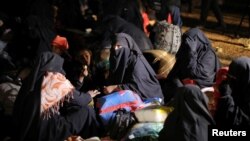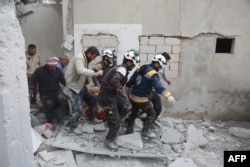The United Nations says in the last three days some 9,000 people have evacuated the final piece of land still held by the Islamic State terror group in Syria.
The U.N. Office for the Coordination of Humanitarian Affairs in Syria (OCHA Syria) said of those fleeing the Syrian village of Baghuz, 99 percent are women and children, and 6,000 civilians have been brought to the nearby al-Hol camp for displaced persons in northeastern Syria.
Just last week, U.S.-backed Syrian Democratic Forces estimated there were only about 1,000 civilians still left in the village, along with about 300 of the “most-hardened” IS fighters.
And on Monday, the London-based Syrian Observatory for Human Rights said a total of about 1,400 people had left Baghuz since Sunday, including dozens of suspected IS fighters.
The number of civilians, both IS family members, as well as prisoners and slaves, still holed-up in a tiny pocket of territory has shocked the SDF, which has been leading the ground campaign against the terror group.
OCHA Syria reports the population of al-Hol is now more than 47,000, with women and children under five years of age making up 75 percent of the displaced.
Commanders now worry that thousands more may still be hidden in a network of tunnels and caves beneath the village, which also may hold an unknown number of IS fighters.
"It is too hard to get a realistic total when the enemy is using tunnels and other hideouts," coalition spokesman Col. Sean Ryan told VOA on Monday.
"Right now, the safety of the civilians in the Baghuz area is paramount, and the SDF is working this complex issue very well and ensuring ISIS fighters do not get through the screening process," he added, using an acronym for the terror group.
SDF commanders have said repeatedly they intend to wait until all civilians are evacuated from Baghuz before they launch a final assault.
Even coalition airstrikes in the area have focused mostly on pushing back IS fighters when they have blocked escape routes in an effort to prevent the civilians from leaving.
Growing concern
In the meantime, SDF officials have been voicing growing concern over the number of civilians and fighters now in their custody.
"The burden which is already too heavy for us to handle is getting even heavier," SDF spokesman Mustafa Bali tweeted on Saturday.
"This will remain as the biggest challenge awaiting us unless governments take action and fulfill their responsibilities for THEIR CITIZENS," he added.
U.S. and coalition officials have said there are at least 800 IS foreign fighters currently in SDF custody, though some SDF estimates put the number at more than twice that.
And while U.S. officials have long been pushing for countries of origin to take back their own foreign fighters and prosecute them, many nations have been reluctant to do so.
But there are indications some countries are finding other solutions.
On Monday, Iraq confirmed it has taken custody of 13 IS fighters from the SDF.
"They are accused of having commanded operations against Iraqis and Iraqi installations in Iraq, and they will be tried according to Iraqi law," Iraqi President Barham Salih said during a visit to Paris, suggesting his country might be willing to prosecute other foreign fighters as well.
"We are acting within the confines of international law on this matter," Salih added speaking alongside French President Emmanuel Macron.
Other Iraqi officials had previously said all 13 fighters were of French origin.
The Pentagon Monday told VOA that despite the apparent agreement, the best way to mitigate any future threat is for countries of origin to repatriate and prosecute their own foreign fighters themselves.
(Some information in this report comes from Reuters.)










